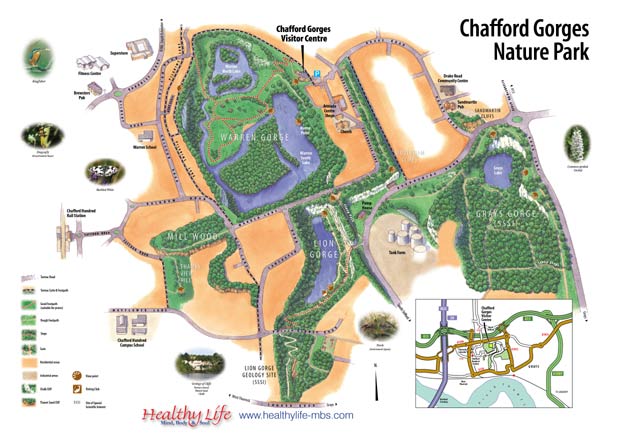Chafford Gorges Nature Park - Healthy Life Essex
Home » Articles » Outdoor Life » Countryside in Essex » Country Parks & Nature Reserves » With Visitor Centres » Chafford Gorges Nature Park

Chafford Gorges Nature Park (Contact details shown at the bottom of the page) lies at the heart of Chafford Hundred in Grays Thurrock. It is a superb area of green space comprising approximately 200 acres of former chalk quarries known as Warren Gorge, Lion Gorge and Grays Gorge together with the connecting land of Mill Wood and Wouldham Cliffs.
Much of the Park is dominated by chalk soil and some of the meadow areas are incredibly diverse with many plant species dependent on the chalk conditions, including kidney vetch, bladder campion, and nine species of orchid including the bee orchid. The range of chalky, sandy and gravely soils also supports a large number of unusual insects of national importance. The site is dominated by several large lakes, woodland and chalk cliffs all of which provide important habitats for a wide range of animals including great crested newts, slow worms, adders, bats, kingfishers and sand martins. It is likely that some of the wildlife in the Park is yet to be recorded, so please keep an eye out for any wildlife you see and let us know of any interesting sightings.
| Open a larger scale copy of this map in Adobe pdf format |
HISTORY OF CHAFFORD GORGES NATURE PARK
The Borough of Thurrock where Chafford Gorges Nature Park is situated has a long history, both in geological and human time. It stretches back to the earliest occupation of Homo sapiens around 200,000 years ago in West Thurrock and Chadwell-St-Mary. Considerable archaeological evidence indicates settlement, farming and industrial development starting around 10,000 years ago in the Mesolithic period and continuing through the Neolithic, Bronze, Iron, Roman and Saxon periods.
From the 18th century to the end of the 1950s a large proportion of Chafford Hundred (predominantly upland chalk area) was extensively quarried for Brickearth (used to make bricks), Gravel, and Chalk (with flint as a side product) which was used to produce lime for mortar, whitewash and from the 1870s, cement. In more recent years some of the derelict quarries were redeveloped for housing and the housing estate consortium adopted the name ‘Chafford Hundred’ in 1987. In June 2005 Chafford Gorges Ltd, a subsidiary of Essex Wildlife Trust took over what is now called Chafford Gorges Nature Park.
Geology of Chafford Gorges Nature Park
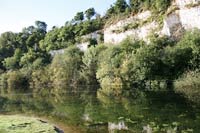 What a fascinating story Chafford’s rocks have to tell – of past dramatic changes in climate and sea level – both issues very relevant today – and of ancient lands, seas and volcanoes. Its Chalk, deposited from 97-65 million years ago, is evidence of a ‘Greenhouse Earth’. This was when dinosaurs still roamed the land – but not at Chafford, as sea level was then around 300 metres higher than today! Our reserve would have been at the bottom of a deep, still, tropical sea. This sea then retreated, allowing erosion of the resulting land surface, before a shallower sea was re- established around 60 million years ago, when the Thanet Sand was deposited. This is present above the chalk in several localities, but is best seen at the Mill Wood Sand Cliff. Much of it originated from ancient rocks in the Scottish Highlands, which were transported more than 500 miles to Essex along the coast by longshore drift. It also contains traces of ash from volcanoes in western Britain, associated with the opening up of the Atlantic Ocean. If you would like to learn more, why not walk our geology trail, guided by the interpretative leaflet obtainable from the Visitor Centre.
What a fascinating story Chafford’s rocks have to tell – of past dramatic changes in climate and sea level – both issues very relevant today – and of ancient lands, seas and volcanoes. Its Chalk, deposited from 97-65 million years ago, is evidence of a ‘Greenhouse Earth’. This was when dinosaurs still roamed the land – but not at Chafford, as sea level was then around 300 metres higher than today! Our reserve would have been at the bottom of a deep, still, tropical sea. This sea then retreated, allowing erosion of the resulting land surface, before a shallower sea was re- established around 60 million years ago, when the Thanet Sand was deposited. This is present above the chalk in several localities, but is best seen at the Mill Wood Sand Cliff. Much of it originated from ancient rocks in the Scottish Highlands, which were transported more than 500 miles to Essex along the coast by longshore drift. It also contains traces of ash from volcanoes in western Britain, associated with the opening up of the Atlantic Ocean. If you would like to learn more, why not walk our geology trail, guided by the interpretative leaflet obtainable from the Visitor Centre.
Warren Gorge
This is the largest gorge in the Nature Park. Much of the meadow found at the bottom of the Gorge has been trans-located from chalk meadows which were on development land near Chafford Hundred Station. It is intended to manage the meadow so as to encourage many of the rare chalk loving plants that are thought to exist in the seed bank in the soil.
Keep a look out in the summertime for a wide range of wildlife including dazzling kingfishers, house martins, grass snakes and common spotted and pyramidal orchids. In the winter time, birds such as siskins, redpolls, pintails and pochards take temporary residence.

Wouldham Cliffs
These superb chalk cliffs form the backbone to the Nature Park. At the most westerly point, breath taking views over Lion Gorge can be enjoyed. In the summertime, keep an eye out (along the cliff top) for the butterflies (meadow brown, ringlet, gatekeeper, large white, holly blue and common blue) and dragonflies and damselflies (Darter dragonflies, common blue and blue tailed damselflies) that inhabit this area. In the future we will be managing this grassland area to prevent scrub encroachment and thereby increase the populations of unusual insects.
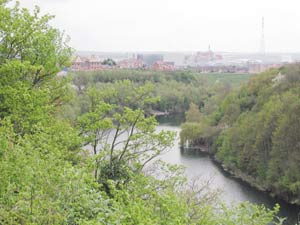 Lion Gorge
Lion Gorge
This Gorge features a large lake and its crystal clear waters host very large populations of a variety of fish species including tench, rudd, pike and bream. A community led fishing club has been set up to help manage these waters. This Gorge is also highly important for bats. Four species have been recorded so far and the numbers of each species surveyed make for a spectacular show on a warm summer’s night. At the bottom of the Gorge, keep an eye out for orchids. We hope to encourage the orchid populations by removing some of the scrub that has slowly taken over the site. At the southern end of the Lion Gorge are cliffs which have 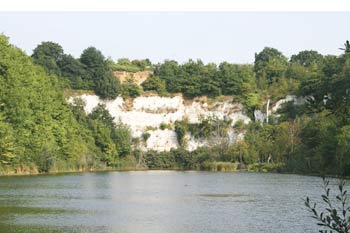 significant Pleistocene Thames deposits. Scientists investigating these deposits have discovered a huge array of fossils including molluscs, ostracods and pollen.
significant Pleistocene Thames deposits. Scientists investigating these deposits have discovered a huge array of fossils including molluscs, ostracods and pollen.
Grays Gorge
Grays Gorge is well known for its diverse and varied species of wildflowers. There are nine species of orchid recorded including greater twayblade, common spotted, heath spotted, southern marsh, birds nest, marsh helleborine, green flowered helleborine, man orchids and last but no means least the bee orchid. Other floral delights include common rockrose, common milkwort, fairy flax and autumn gentian. There are, as you can imagine, far too many plants to list here, so keep a look out for rarities. Grays Gorge is also important for a wide range of animals including a variety of reptiles (adders, slow worms, grass snakes), butterflies (grayling, green hairstreak, holly blue), birds (willow warbler, lesser spotted woodpecker) and a whole host of other nationally important animals such as bee, wasp and beetle species.
 Mill Wood
Mill Wood
Mill Wood is an ancient woodland and it is thought to support a wide range of wildlife (particularly nationally important invertebrates such as bees and wasps), but further work is necessary to update our knowledge of the Wood. Superb cliff exposures are visible (read the Geology of Chafford Gorges section) and excellent views over the Thames Estuary.
The Next Steps and for More Information
Chafford Gorges Nature Park was taken over by Essex Wildlife Trust on 9th June 2005 and the Visitor Centre opened in April 2006. Visitors will be able to get involved with various activities including volunteer work parties, guided walks and talks etc. and there will be plenty of activities for local school children and college students. (see Healthy life events pages)
Location, opening Times and contact details:
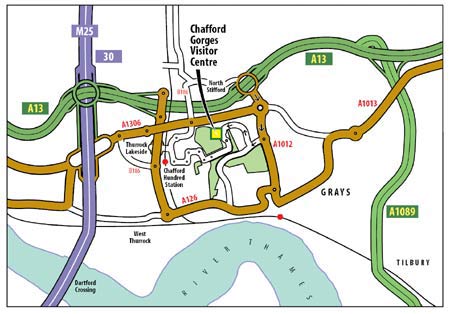 HOW TO FIND US
HOW TO FIND US
By Road: -see map.
By Bus: 98 – from outside Chafford Hundred Rail Station (weekdays only) 40A, Grays Bus Station (weekdays only)
80, Grays & Chafford Hundred Rail Station.
By Train: Nearest Station – Grays or Chafford Hundred
Address: Drake Road, Chafford Hundred, Grays Thurrock, RM16 7RG
Opening Times:
Visitor Centre: Tuesday to Sunday: 9am – 5pm
Nature Park: 24/7
 For more information on Chafford Gorges Nature Park, please contact the Visitor Centre 01375 484016. email: chafford@essexwt.org.uk
For more information on Chafford Gorges Nature Park, please contact the Visitor Centre 01375 484016. email: chafford@essexwt.org.uk
or visit the web site: www.essexwt.org.uk

